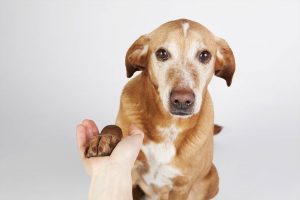Posts by Dr. Lelan Olsen
Pet Gift Guide For The Holidays – 2019
 No matter how a pet comes into your life, there is a bond that you share with it. Pets can be quirky, happy-go-lucky, weird, smart, grouchy, or even lazy. Whatever their personality the don’t ask for much but maybe a little attention, love and care. With the holidays right around the corner, it is a tradition that I highlight some of the unique pet safe toys, treats and equipment that I have found throughout the year. By no means will this list be all-inclusive, but if “mans-best-friend” is still on your shopping list, this may help give you some ideas that will please then.
No matter how a pet comes into your life, there is a bond that you share with it. Pets can be quirky, happy-go-lucky, weird, smart, grouchy, or even lazy. Whatever their personality the don’t ask for much but maybe a little attention, love and care. With the holidays right around the corner, it is a tradition that I highlight some of the unique pet safe toys, treats and equipment that I have found throughout the year. By no means will this list be all-inclusive, but if “mans-best-friend” is still on your shopping list, this may help give you some ideas that will please then.
Bike Tow Leash – From Amazon, this leash attaches to the left side of most bikes or wheelchairs. It allows you to walk or run your dog without worrying that the dog or the leash will become entangled in your bike wheels.
Mudbuster Paw Cleaner – Also available on Amazon, this cup with a silicone top and tendrils inside allow you to wash off your dog’s paws one at a time quickly and without a mess.
Bacon Bubble Blower – Sorry to burst your bubble, but this toy will keep your dog popping with excitement as it chases these 100% non toxic, tear free bubbles that are made from a bubble blower that is also available on Amazon.
Bark Snoot Scoops – From Bark Shop, this ice cream treat is the perfect way to keep cool next summer especially after laying out by the pool. Its’ ingredients include nonfat dried whole milk, dried cane molasses, dried banana and blueberries, goat’s milk, vanilla and gelatin.
Splatter Pet Sweatshirt – These sweatshirts are a trendy sweater that supports a good cause. The company that makes these-Found My Animal-gives back to shelter dogs in need and promotes adoption with every purchase.
Furbo Dog Camera – If you have a need to check in with your pet while you are away, this camera is highly recommended and has some fun features, like 2-way audio and the ability to dispense treats.
Wild One Carrier – Not only is this pet carrier stylish, it is waterproof, padded for your comfort, breathable, and has a unique cut out so your pet can see what is going on.
Pet Teepee Tent – This pet oasis definitely won’t be an eyesore in your home. Plus, it is comfortable, machine-washable, and the price won’t break the bank. It is made by Huts and Bay.
NOW FOR THE CAT LOVERS!
Bergen Turbo Scratcher Cat Toy This toy stands out as a clear winner thanks to its combination of durable scratch pad, entertaining ball track and irresistible catnip.
Petstages Tower of Tracks Available on Amazon, this track toy combines three levels of circular tracks, each with their own brightly colored ball. It is intended to stimulate your cat’s instincts and encourage them to play. The balls are fixed in place thanks to closed tracks. It encourages the cats to play independently, but also provides options for you to play with your cat. Multiple cats can also play.
Hexburg Mouse Cat Toy It is if your cat loves to pounce and chase. With realistic and random movements, your cat will have hours of fun with this mouse. It is able to navigate around furniture, can flip back onto its feet when overturned, but is suitable for hard wood floors only.
Friends Forever Cat Laser Toy It is packed full of features that means that your cat will be kept entertained and exercised through healthy play. The eye-catching diamond shaped pointer on the top of the toy is designed to attract your cat by rotating to cast a laser in a range of unpredictable directions.
From all of us here at the Olsen Veterinary Clinic, we would like to wish each and everyone a warm, blessed, and safe holiday season with hope for a very prosperous and healthy 2020. Please don’t hesitate to call us at (618)-656-5868 if you have any concerns or questions.
Why You Should Keep Your Pets Away from the Table This Thanksgiving
 With Thanksgiving approaching, there is no doubt that you pup is going to want to partake in the festivities. However, feeding your pup even a few tasty treats from the table is definitely not the way. More often than not, table food is typically too fatty for a dog’s digestive system and can result in severe stomach upsets. To keep your dog safe and healthy this holiday season, keep the following in mind.
With Thanksgiving approaching, there is no doubt that you pup is going to want to partake in the festivities. However, feeding your pup even a few tasty treats from the table is definitely not the way. More often than not, table food is typically too fatty for a dog’s digestive system and can result in severe stomach upsets. To keep your dog safe and healthy this holiday season, keep the following in mind.
Oily and fatty foods, which are often found on OUR tables, can lead to severe dog health problems such as diarrhea, vomiting, and pancreatitis. Even worse, there are several people foods that can be toxic to dogs. For example, onions or any food prepared with them are unsafe for dogs and should never be given to them. Moreover, dogs that are constantly fed with table scraps have the tendency to become dependent on them. Dogs that eat table scraps may start refusing to eat regular dog food. Feeding your pet with table scraps can also cause them to develop bad behaviors such as begging. If you wish to reward your pet for good behavior, give them treats made for them.
If for some reason you just cannot stop feeding your pet table scraps, follow the following rules:
No junk food! Never feed your dog junk foods such as fries, potato chips, leftover pizza, or candies. Your dog should only get healthy food items like steamed or baked potatoes, plain rice, oatmeal, bits of cooked chicken or turkey, finely chopped or steamed unseasoned veggies and certain fresh fruits.
Moderation is key! If you like giving your dog healthy people food, don’t forget to factor his meals into his daily calorie requirement, then, feed your pooch less of their own dog food so they don’t gain weight. Be sure to balance their diet since your dog still needs their regular food. Just try giving less of it on times when you are feeding him with healthy table scraps.
Watch out for toxic food! Above all, you should avoid foods that have been found to be poisonous to dogs. These include, for example, raisins, onions, chocolate, cooked bones, fruit pits, and walnuts. For a more complete list, check it out here.
If you wish to feed your dog human food, a great way to do it is to cook a recipe specifically designed for dogs. These often include scraps that pose no harm to your dog, including rice, cooked eggs, carrots, cheese, peanut butter, berries, chicken, green beans, seedless watermelon, and bananas.
As always, feel free to reach out to Olsen Veterinary Clinic with any questions at 618-656-5868.
Kennel Cough: What You Need To Know
 Doggy daycare, like regular daycare, can be a cesspool of different germs and infections. If your dog comes home from daycare with a strange cough, your dog might have contracted kennel cough. Kennel cough can be caused by a variety of different viruses and bacteria. Kennel cough is caused by a dog inhaling bacteria or viruses into their upper respiratory tract. Symptoms can be worsened if their lungs are already overworked by cold air, cigarette smoke, stress, or crowded quarters with poor ventilation.
Doggy daycare, like regular daycare, can be a cesspool of different germs and infections. If your dog comes home from daycare with a strange cough, your dog might have contracted kennel cough. Kennel cough can be caused by a variety of different viruses and bacteria. Kennel cough is caused by a dog inhaling bacteria or viruses into their upper respiratory tract. Symptoms can be worsened if their lungs are already overworked by cold air, cigarette smoke, stress, or crowded quarters with poor ventilation.
The respiratory tract is usually lined with mucus which helps trap particles that might cause infections which is why kennel cough is often caused by multiple different pathogens – one weakens the mucus in the lungs allowing the other to take root and cause infection. Kennel cough is extremely contagious and spreads around the environment where other dogs inhale the pathogen and become sick. Kennel cough is difficult to control since it is airborne. The main symptom of kennel cough is a cough that sounds like a goose honk. Some dogs will only experience coughing with kennel cough while others may have other symptoms such as sneezing, a runny nose, or eye discharge.
Severe symptoms may include retching, lethargy, and fever. Usually kennel cough lasts for three to four weeks with the worst symptoms in the first five days and dwindling over time. Young puppies and older dogs with weakened immune systems are more susceptible to kennel cough and can take up to six weeks to recover. Stress and environmental factors like temperature, dry climate, and airborne irritants like smoke can increase the severity of prevalent symptoms.
Vaccines for kennel cough are extremely important as they can reduce the odds of getting it or reduce the symptoms. While the vaccine is not 100% effective, it can greatly reduce the odds of your dog contracting the illness if they is frequently in conditions that tend to spread the disease, such as daycare. The vaccine is typically offered in oral, intranasal, and injected forms. The biggest mistake believed by some is that kennel cough is a minor issue that doesn’t call for a trip to the vet. While it may seem like a minor problem, kennel cough can lead to pneumonia or death, especially in dogs that already have weakened immune system.
It’s better to be safe than sorry and take your dog to the vet at the first signs of kennel cough, rather than waiting for the issue to progress. Your vet will be able to tell you how severe of a treatment needed to help your pets kennel cough. A mild cough may only need rest and a cough suppressant while severe kennel cough may require antibiotics or supportive care. Coughing is not only indicative of kennel cough; it may also indicate major health issues such as a collapsing trachea, canine distemper, canine influenza, bronchitis, asthma, or even heart disease. It is always best to err on the side of caution and bring your dog to the vet at any sign of coughing.
There are several home remedies that may help soothe your pet’s symptoms and reduce discomfort. Create a humid environment by using a humidifier or turning on a hot shower and putting your dog in the bathroom with the steam. Some dog owners have found that a small amount of honey daily can help a dog’s throat. Honey has natural antimicrobial and anti fungal agents that can reduce inflammation and soothe sore throats. Thus, reducing coughing while helping your pup fight off infection. Simply give your dog a spoonful of raw honey a few times a day. As always, be sure to check with your vet before introducing human food into your dog’s diet. Another option to consider is CBD oil. It is natural found in hemp plants and highly regarded for its health benefits. The anti-inflammatory properties of CBD oil can ease pain and swelling, restoring comfort.
Kennel cough is not a common cold. It is best to visit your veterinarian right away to learn of the best treatment path. As always, feel free to contact Dr. Olsen at 618-656-5868 with any questions or to set up an appointment.
Dr. Olsen’s Breed Spotlight: The Peruvian Inca Orchid
 The Peruvian Inca Orchid is not a flower, but a hairless sighthound that developed in Peru. The breed can be hairless or coated and can be found in a range of sizes. These dogs are good hunters and do well in agility. In the hairless variety, the skin can be of any color. The coated variety features all colors as well including black, brown, pink, tan, and white. On a sunny day, Peruvian Inca Orchids require sunscreen because of their exposed skin.
The Peruvian Inca Orchid is not a flower, but a hairless sighthound that developed in Peru. The breed can be hairless or coated and can be found in a range of sizes. These dogs are good hunters and do well in agility. In the hairless variety, the skin can be of any color. The coated variety features all colors as well including black, brown, pink, tan, and white. On a sunny day, Peruvian Inca Orchids require sunscreen because of their exposed skin.
The ancient history of the Peruvian Inca Orchid can be told through pottery and textiles. The breed first appeared in Moche pottery in 750 AD. The Chancay people used the dogs as companions, and certain pottery even depicts them in sweaters. The Chimu considered them good luck and used the dogs’ warmth for the treatment of arthritis and respiratory conditions.
The original hairless dogs were small companion animals, but when Peru was conquered by the Conquistadors, the small dogs were interbred with the dogs of the foreigners and over the years, three distinct sizes developed. In the mountainous regions, the Andean people protected the dogs, but the breed did not fare well in the cities along the coast. There, the hairless dogs were considered diseased and were often exterminated.
In 1966, an American, Jack Walklin, visited Peru and brought eight dogs back to the US. He is believed to be the one to have named the breed the Peruvian Inca Orchid and the breed was established under that name in the US and Europe. In 2001, Peru declared the breed a National Patrimony and the dogs are now protected in Peru.
Peruvian Inca Orchids come in a range of sizes with the smallest standing just short of 10” and the largest topping out at 26”. The distinguishing feature of a Peruvian Inca Orchid is their hairlessness. Their skin can be a solid color or spotted with unpigmented areas. Peruvian Inca Orchids that are coated are in the minority and can occur in the same litter with hairless Peruvian Inca Orchids.
Peruvian Inca Orchids are slim dogs who are very noble and affectionate to those close to them. At the same time, Peruvian Inca Orchids are lively, alert, and can be wary of strangers. Peruvian Inca Orchids make good watch dogs. Peruvian Inca Orchids are loyal and protective of their family but like all dogs should be supervised around children. If you have small pets, the Peruvian Inca Orchid might not be the dog for you as Peruvian Inca Orchids might mistake your small pet as prey.
What To Do If Your Dog Gets Into A Fight With Another Dog
 Dogs often wrestle and playfully bite each other. It’s just part of puppy play time. Sometimes, the wrestling turns into a full-blown dogfight. If the fight doesn’t seem to show signs of stopping, it’s important to step in before one of the dogs get hurt.
Dogs often wrestle and playfully bite each other. It’s just part of puppy play time. Sometimes, the wrestling turns into a full-blown dogfight. If the fight doesn’t seem to show signs of stopping, it’s important to step in before one of the dogs get hurt.
Most dogfights only last for a few seconds. It’s important to stay calm and clear headed. Resist the urge to grab your dog by the collar. It might be your first impulse, but when dogs are really fighting, they may whip around and instinctively bite your hand without any past aggression. You are able to tell that it’s a real dogfight when the dog’s bodies are rigid. To stop the fight, make as much noise as possible. You can yell, shriek, stomp your feet, clap your hands, etc. Do whatever you can to attract the dogs’ attention. Similarly, you can use water to get their attention. You can douse the dogs with a hose, bucket of water, etc. (If you are going to a new dog park or unfamiliar place, bring a spray bottle just in case a fight breaks out.) You can also use a barrier such as a large piece of cardboard, plywood, even a big stick to split them up. The large barrier acts as a way to split them up without risking your hands. Lastly, you can throw a blanket over the dogs. Some dogs will stop fighting when they can’t see each other anymore.
It’s important to know when you should step in. Scuffles between dogs last only a few seconds and can appear worse than they actually are. Fights involving fighting breeds should be stopped as they have trouble reacting to social signals from other dogs. Fights between dogs of two very different sizes or two females in heat will need to be broken up; as well as fights involving dogs who are known to have done physical harm in the past or will not walk away. Under no circumstances should you get between the two dogs. You can grab your dog from behind and grab the top of its hind legs, so it is in a wheelbarrow position. You can then walk backwards circling to one side so the dog will not be able to turn and bite you. After you stop the fight, be sure to separate the dogs and keep them out of each other’s sight. This prevents the chance that the two dogs may start fighting again.
To ensure that fight never happens, observe how your dog interacts with other dogs. Does your dog bark, pounce, and snap at other dogs? Do they play rough normally? If you know how your dog acts normally, you will be able to know when a fight is getting ready to begin. When dogs play, it often sounds a lot like it does when they’re fighting. Dogs will growl, snap their jaws, and bite one another roughly. Instead of listening, watch the dogs’ bodies. If they look loose and relaxed, and they’re wagging their tails, they’re probably just playing. However, if the dogs’ bodies appear stiff and rigid, and their tails are down, they may get ready to fight. If one dog thinks it is play time and the other isn’t seeing it as fun, it is best to separate them to avoid any fighting. To further prevent fighting, don’t encourage competition. Dogs get territorial over food and toys. Some breeds are more apt to defend their rights to beloved possessions while some are more apt at sharing. Be sure to know your dog’s unique personality traits so that they can prevent a battle from happening when another dog comes around. You can put treats, food, and toys away when your dog is having social time with another dogs and feed multiple dogs in separate rooms.
Preventing fights start from when the dogs are young puppies. Teach them to play nicely. Use positive reinforcement to reward good behavior. When your dog bites, growls, or exhibits other violent behavior, separate them from the dog that they are playing with and put them in time out until she calms down. Similarly, make sure that your dog knows to come when they are called. If your dog is good at obeying your call to come, you’ll be able to pull them out of tense situations before a fight may start.
As always, feel free to contact Dr. Olsen at Olsen Veterinary Clinic by calling 618-656-5868.
Dry Drowning: What Is It And How Do I Prevent It For My Dog
 Everyone knows of drowning when a person or a pet is submerged in water and can’t get oxygen. Have you heard of dry drowning? Dry drowning occurs when water is aspirated into the lungs or other parts of the airway. If the water doesn’t make it to the lungs, the vocal cords can begin to spasm making breathing difficult. If water does make its way to the lungs, serious complications and even death may occur. The latter condition is referred to “secondary drowning”, but it’s usually also referred to as dry drowning. Dry drowning is a scary thing as it can ‘happen’ HOURS after exposure to water. It’s something that affects all animals with exposure to water, from humans to dogs.
Everyone knows of drowning when a person or a pet is submerged in water and can’t get oxygen. Have you heard of dry drowning? Dry drowning occurs when water is aspirated into the lungs or other parts of the airway. If the water doesn’t make it to the lungs, the vocal cords can begin to spasm making breathing difficult. If water does make its way to the lungs, serious complications and even death may occur. The latter condition is referred to “secondary drowning”, but it’s usually also referred to as dry drowning. Dry drowning is a scary thing as it can ‘happen’ HOURS after exposure to water. It’s something that affects all animals with exposure to water, from humans to dogs.
How does dry drowning happen? It can be brought on by a dramatic water event or just a typical bath. A dog whose head goes under the bathwater is just as susceptible as a dog who actively jumps into the pool. In a lot of cases, dry drowning doesn’t look like much at all as the condition starts to shape.
Dry drowning is caused by swallowing water. That’s it! For a moment, consider how large your dog’s mouth is and imagine what it feels like when you go underwater unprepared. The natural instinct is to gasp for air, and it is unavoidable. If your dog has the same instinct, your dog could swallow a lot of water in just one gulp.
If water has gotten into your dog’s lungs, it could take hours or in some cases even days for signs to show. The most common symptoms include coughing or hacking, signs of chest pain, difficulty breathing or wheezing, and extreme lethargy. If you suspect your dog may be suffering from dry drowning, take your dog to the vet immediately. Even if your dog doesn’t seem to be in duress, it’s best to have your dog checked out just to be sure.
It’s important to note that dry drowning can happen as a result of swallowing sand as well. A dog who respirates a lot of sand can suffer the same ill effects of secondary water drowning and should be checked out by a vet.
To protect your dog from dry drowning, be sure to monitory your dog closely around water. Even if your dog is a prolific swimmer, you want to keep an eye on your dog to make sure that a swallowing episode doesn’t occur. It only takes one swallow to dry drown. If your dog is around water frequently, invest in a fitted life jacket to ensure that your dog’s head stays above water as much as possible. HERE is an article from the American Kennel Club listing multiple safe options. Even though most dogs can doggie paddle, their arms get tired just like ours do. Lastly, always take “near” drowning seriously. Even though dogs have a natural swim instinct, if you ever have to “rescue” your dog from the water you should watch her closely for several days afterwards to look for signs of secondary drowning.
As always, if you have any questions or wish to make an appointment, contact Dr. Olsen at Olsen Veterinary Clinic or call us at 618-656-5868.
How To Protect Your Pet From The Heat
 Protecting your pet from the heat is extremely important. As temperatures rise, it becomes more and more uncomfortable to be outside. This is true for your dog as well. During the summer, it is healthier for your dog if you limit outside time, time in dog parks, and exercise to cooler parts of the day, such as morning and evening times. It is not always the temperature as well. The humidity can cause your dog to have difficulty panting. Panting helps your dog cool itself off. Without being able to pant, your dog’s temperature can rise that can lead to heatstroke. If your dog is exhibiting any of the signs of overheating (heavy panting, heavy drooling, trouble breathing, rapid heartbeat, dark or red gums and tongue, dizziness, and weakness, or agitation), be sure to bring your dog to the vet right away. To avoid overheating, there are multiple things that you can do to keep your puppy cool during the hot summer.
Protecting your pet from the heat is extremely important. As temperatures rise, it becomes more and more uncomfortable to be outside. This is true for your dog as well. During the summer, it is healthier for your dog if you limit outside time, time in dog parks, and exercise to cooler parts of the day, such as morning and evening times. It is not always the temperature as well. The humidity can cause your dog to have difficulty panting. Panting helps your dog cool itself off. Without being able to pant, your dog’s temperature can rise that can lead to heatstroke. If your dog is exhibiting any of the signs of overheating (heavy panting, heavy drooling, trouble breathing, rapid heartbeat, dark or red gums and tongue, dizziness, and weakness, or agitation), be sure to bring your dog to the vet right away. To avoid overheating, there are multiple things that you can do to keep your puppy cool during the hot summer.
To begin, make sure to keep your dog groomed, especially if they have long fur. Each breed has different needs. For example, dogs with short, thin coats handle heat better than cold weather and mountain dogs. No dog is immune to heatstroke or paw pad burns, so it’s important to keep your dog groomed. If you get any mats and tangles out of their fur, it will help keep them cool. However, don’t shave or clip their coat until you talk to your vet or groomer. The extra fur that helps your dog stay warm in the winter may also keep it cool in the summer. To keep your dog’s paw pads safe, stick to shaded areas or bring insulation booties to protect your dog’s feet from the hot pavement. To test the heat of the pavement, feel it with the back of your hand. If it is too hot for you, then it is definitely too hot for your dog.
Similarly, be sure to keep your dog’s shots up to date, especially in the summer. The parvovirus spreads in hot weather. During the summer, your dog probably spends more time outside which means that it could come in contact with an animal that has rabies. Summer is also a high season for fleas and mosquitos, both which carry many diseases. By giving your dog medication to prevent these pests, your dog will be safer in the long run.
This should go without saying but leave your pet at home unless your destination is pet friendly. Do not leave your pet in your car. Even with the windows of your car cracked, the temperature inside the car rises rapidly in the summer heat. Similarly, keep your dog’s water supply full. Be sure that there are multiple bowls available for your dog that are always filled with fresh water that is clean. Even if you think that the walk you are going on will be short, be sure to bring clean drinking water and a dish that your dog can easily drink from. If you are worried that your pet is not drinking enough water, add some ice cubes to the bowl. It will make drinking water more appealing to dogs.
When you are spending days outside by a pool or a lake, you can do many things to keep your dog cool while you enjoy the summer sun. You can freeze containers of water so that they will stay cooler for longer. Be sure to keep their water in the shade. You can also provide a small kiddie pool or a sprinkler for your dog to play in. These allow fun places for your dog to cool off and maybe even get some exercise. Similarly, you could put a pet-friendly dig area for your dog in your yard. These can include a sandbox area that your dogs are able to dig in. Dogs often dig a hole to sit in and keep cool. To make an even cooler area, you can spray sand with your cold water. Be sure to make sure that it is located in the shade and not in the sun.
Sometimes, a little extra help is needed to cool your dog. Dog cooling mats and cooling vests are great products. Many work by soaking them in cool water for a long time. If you don’t have access to these, you can soak a towel in cool water and let your dog lie on it. You can also spray your dog’s belly and paws to cool them down. Dogs will cool down more quickly through their belly and paws than water sprayed on their back. Another great DIY to keep your dog cool is to put a pan of ice water in front of the fan to make it more effective for your pup to stay cool.
There are many similar DIYs to keep your pet cool in the summer. Dog-Safe ice cream exists, and you can make it at home. Here is a big list of easy to make ice creams that won’t cost an arm and a leg unlike the gourmet pet store ice-creams. You can also make some frozen treats to put in your dog’s favorite toy. Kong toys come in all shapes and sizes because all dogs love them. They are tough rubber chew toys that are meant to be filled with yummy sticky treats like peanut butter to keep your dog occupied for a while. There are pet-friendly recipes available that are meant to be frozen to keep your dog refreshed while they lick the center. Similar to the Kong treats, you can freeze your dog’s favorite treats in a popsicle mold and fill it with water. It will give your dog a fun treat to keep them cold.
The summer gives many fun opportunities for you and your family. You wouldn’t allow a member of your family to overheat, so don’t let your dog (a furry family member). By following the simple rules of pet care and making some fun treats that your dog will enjoy, you and your dog can have a healthy and cool summer! Make sure to contact our office if you have any questions!
You CAN Teach An Old Dog New Tricks!
 We have all heard the saying, “You can’t teach an old dog new tricks.” Not true! Yes, you can!
We have all heard the saying, “You can’t teach an old dog new tricks.” Not true! Yes, you can!
Most people associate training with young puppies, but the reality is that dogs are able to learn at any age. Surprisingly, adult dogs are often easier to train than younger puppies because they have more self-control. Whether you just adopted an adult dog, or your older pet needs to learn some new tricks, training offers mental stimulation and keeps your dog’s mind sharp. It is important that you be patient when training both adult dogs and puppies. If you have just brought an adult dog to your home, allow the dog time to adjust. Adult dogs have their own histories that may make them nervous about new surroundings. Don’t give up on the dog after only a few days. Adult dogs may need a period of adjustment which can take anywhere from a few days up to a month. Once the dog realizes that they have found their forever home, it will soon settle into being a part of the family.
Similar to housetraining a puppy, you should use a crate when housetraining an adult dog. You cannot assume that an adult dog is housetrained so you should keep it in a crate when you are not able to supervise it. When you release your dog from the crate, take your dog immediately to the place outside where you want your dog to relieve himself. If it does not relieve itself, re-crate your dog and try again later. Be sure that your crate is large enough and strong enough for your dog to fit comfortably. Your dog should be able to stand up, move around, and stretch out without difficulty. Soft-sided crates are often too flimsy to stand up to the needs of an adult dog so the best option is usually a metal crate that can be folded for easy transportation. Be sure to provide your crated dog with water, soft blankets, and chew toys as well as enough attention, exercise, and outdoor time so your dog can relieve itself.
If your dog is new to crates, introduce the concept slowly. Entice your dog to enter the crate by offering food and keep it in the crate for only a few minutes at first. Be sure to avoid using the crate as a form of punishment or leaving your dog isolated in its crate for long periods. The housetraining process usually goes by quicker for older dogs as they have more control over their bladders and bowels than young puppies do.
Whether you just brought your adult dog home, or your adult dog needs some training, an obedience class is a great place to do it. Obedience classes allows you and your dog to learn basic commands, such as lying down and walking on a loose leash. Even if your dog has never had any obedience training in the past, your adult dog will benefit from the class. Obedience classes also allow your dog to socialize with other dogs and people. You will be able to see how it reacts to other dogs and strangers and gives you the comfort of having a safe environment and a professional dog trainer on stand-by to offer advice.
If you bring an adult dog into your home, they may do things that they were allowed to do in their previous home that you do not want them to do in your home such as jumping on guests or lying on the furniture. To help your dog learn the rules of your house and more importantly, retrain them, be sure to start teaching the rules to your adult dog as soon as possible. The “Nothing in Life is Free” (NILF) dog training method is an effective way to teach your dog self-control. It requires that your dog behave appropriately before getting a desired treat, walk, or positive attention. Lastly, it is important that everyone in the household is on the same page. When different members of the family have different expectations on behavior, commands, and expectations, it can be confusing for the dog. When everyone agrees on appropriate behaviors and uses the same commands and rewards, your dog will learn faster and retain the training longer.
Most often, new owners of adult dogs do not know the experiences that the dog has had with training in the past. Positive reinforcement methods are the best bet for training. Using treats and plenty of praise is an effective method for training dogs of all ages and breeds. Keep things fun and upbeat instead of punishing your adult dog. It is a great way to strengthen the bond between you and your dog. It may take some work at the beginning, but teaching your dog the basic commands and working on solving behavior problems from day one means that your dog will soon settle into being a happy and healthy part of your home.
We are here to help you regardless of the age of your pet. If you have any questions, do not hesitate to contact our office!
Tips For Welcoming A New Puppy Into Your Family
 After three years of having a dog-less house with the passing of our beloved Chocolate Lab Ruby, the Olsens are getting a new puppy. Part of me is still in denial, and part of me is apprehensive as to what we need to do to prepare for a new puppy, which is something that we had not had to do in about 13 years. So now that the purchase is done, it is time to ready the home for our newest member, prepare the prior residents (our cats) for invasion of another four-legged friend, and purchase the supplies and equipment needed for the puppy.
After three years of having a dog-less house with the passing of our beloved Chocolate Lab Ruby, the Olsens are getting a new puppy. Part of me is still in denial, and part of me is apprehensive as to what we need to do to prepare for a new puppy, which is something that we had not had to do in about 13 years. So now that the purchase is done, it is time to ready the home for our newest member, prepare the prior residents (our cats) for invasion of another four-legged friend, and purchase the supplies and equipment needed for the puppy.
Preparing the Home
We all know that puppies get into everything. So we will need to act like a forensic detective and get down on our hands and knees to look for things that a playful puppy might foresee as fun. Items like electrical cords should be tied out of reach. Dangerous products such as cleaning supplies and other items should be locked in a cabinet or placed out of reach. Any valuable items or family heirlooms need to be kept out of reach so they do not become your puppies new chew toy. Lastly, unless you want to be like Imelda Marcos and purchase a new pair of shoes each week, it is best to make sure your shoes are stored away in a closet and the door is secured.
Puppies are always looking for their next meal, so garbage can be enticing to them. In order to prevent them getting into the trash, it is wise to have trash cans that have sealed lids.
The puppy should not have free reign of the house, so you will need to have gates and barriers to keep him in his allowed space. This will also include a kennel for his nighttime bed, which I will talk about later in the article.
No puppy will be an entirely indoor dog unless it is in a big city with little green space. So here in Madison County, Illinois, we will want to examine the outdoor area so that there are not any chemicals or poisonous plants that will entice the inquisitive puppy. Your new puppy may be the cutest thing that you have ever seen, but your neighbor may not have the same opinion. And they always say that a good fence makes good neighbors. So it may be important to make sure that you have one that doesn’t allow your pet to roam free.
Items to Have
As I eluded in the last section, in my opinion, it is best to kennel train your pet. No, this is not seen as “doggie jail” to the pet, but as I explain to my clients, it is best to treat a kennel as it is their bedroom and their place of security. I recommend that you get a larger one as they get larger. It should start as one that is just big enough for them to sleep in. If it is too large, that will allow them to urinate and defecate in the kennel and may inhibit the potty training outside.
I am not an advocate for “potty pads.” I feel that they are just condoning bad behavior by the puppy. The learning puppy will get confused by our laziness that more or less tells it that “they can go here but not there in the house.” To a puppy, this thinking may be problematic.
Obviously we want food bowls as well as toys to keep it occupied when you can’t give it the attention it needs. With the toys, I recommend that they be they type that are indestructible like “Kong toys.” Avoid those that they can easily chew up and have the possibility of ingesting.
A new owner will want to have a collar and a leash. When you take your pet out on walks, it will be necessary to have these to protect your pet from injury by other pets or getting ran over by a vehicle.
Grooming brushes are important to have especially with those puppies that will have long wooly coats. They will need to be brushed frequently to prevent matting and tangling.
I am not a big proponent of treats, but they would be alright to have on hand, but I caution the owner to use them in moderation.
Bringing it Home
The big day to bring the puppy into your household is here, so what should you do?
Many people erroneously allow their new puppy to roam free and explore the house. This is sensory overload. Too many new places, new smells and people at once may confuse him. Instead, let him explore a designated area, perhaps where his food and water are. Or he can acclimate himself to a small puppy-proofed space where his kennel is. Then introduce him to the rest of the house one room at a time, skipping the areas that you want off-limits to him.
It is best to introduce your new puppy to its’ new owners one at a time. I know that they are cute and cuddly, and everyone wants to meet him, but that can create too much excitement for the puppy and may stress the puppy out. So it is best to let him meet each family member quietly and make it rewarding and pleasant.
As previously mentioned, puppies love to chew, so make sure that he has a safe chew toy. If he starts to chew on anything else, redirect him to the chew toy.
It is important that your new puppy know where its’ sleeping quarters are. Puppies sleep between 15-20 hours a day, and likely they will drop in their tracks. It is important to take him to his crate when he seems to be ready to nap and at bedtime. Contrary to what most people think, this is not “doggie jail” as the puppy will associate this as a safe and secure place.
House training starts on day one. Your puppy needs to know exactly where you expect him to do his business. Prevent accidents by monitoring the puppy and take him outside accordingly. This helps him to learn where not to go. Accidents happen, but don’t scold the puppy. Clean up the accident with an enzymatic cleaner.
Teaching your new puppy basic behaviors like watch me, sit, or down are important. With positive reinforcement based training, you can encourage good manners in very young puppies.
Obedience training for your new puppy is always important. It will teach basic manners that can lead to all kinds of fun dog activities and provide socialization with other dogs and humans.
In a few weeks, I will be reliving the excitement that our family experienced 13 years ago. Getting a new puppy can be an exciting and stressful time in any household. It teaches our children to be responsible and committed. So if you need advice or any tips in preparing for the new family member, please do not hesitate to contact or call the Olsen Veterinary Clinic at 618-656-5868.
Why Your House-trained Dog Still Poops Inside and What to Do About It
 When your house-trained dog starts having accidents inside of the house, it can be very frustrating. You may be wondering why. Fortunately, this issue can be fairly easy to fix once you determine what is causing it.
When your house-trained dog starts having accidents inside of the house, it can be very frustrating. You may be wondering why. Fortunately, this issue can be fairly easy to fix once you determine what is causing it.
Your dog may suddenly start having accidents in the house if their normal outside environment is overstimulating or distracting. Dogs get distracted by new smells, pets, etc. which can cause them to forget that they need to go to the bathroom. To fix this, you should make a routine for your dog to go to the bathroom before they get to play. Avoid talking and interacting with your dog when he is sent outside. If you play with your dog, only do so after he has gone to the bathroom. Sticking to this schedule can eliminate the indoor accidents associated with overstimulation.
Other causes of indoor accidents can include fear and anxiety. If your dog is scared of something in the normal outdoor environment, your dog may not feel comfortable enough to go outdoors. To deal with fear related indoor accidents, you can take your dog outside when it is quiet (e.g. avoiding large trucks driving down the street). If you have recently rescued a fearful dog, it might be best to temporarily train them to use pads inside until they have adjusted to the new environment.
Similarly, changes in schedule can cause indoor accidents. These can include new pets and family members being around the house. Dogs are creatures of habits and changes in their lives can disrupt their schedule. Puppies tend to use the bathroom a few minutes after eating, drinking, playing, or napping while adult dogs tend to go early in the morning, mid-day, early evening, and right before bed. To deal with this issue, keep dogs on a very consistent schedule including feeding times and bathroom times. If you keep this schedule consistent, you will likely see an improvement right away.
A poor diet can also cause indoor accidents. Feeding cheap foods from your supermarket may yield more frequent and bulkier bowel movements. For this reason, a premium dog food is preferable since more nutrients are absorbed and hence less waste is produced. This means smaller stools and on a less-frequent basis. To reduce the amount of waste your dog produces and lessen the number of indoor accidents, feed your dog homemade food (recipes can be found online) or high-quality foods. As a rule of thumb, feed your dog natural or organic brands when possible.
When adopting puppies and if they are over eight and a half weeks old, they have a substrate preference. This means that they have a preference to the surface that they like to go to the bathroom on. If a puppy was trained to use pads instead of grass, it will be a difficult transition for them to start using grass immediately. The dogs may hold it until they find a surface that they like which could be your carpet.
Some possible medical causes to indoor accidents range from kidney issues to dietary problems. If your dog was reliably housetrained in the past and recently began having accidents, it is best to bring your dog to set up an appointment to accurately diagnose and treat your pet.
Simply enough, your dog might be old, or they might be inside for too long. You should not scold your well-trained dog for soiling in the house when they are inside for too long.
Lastly, dogs have a natural instinct to relieve themselves where they have done it before. Your dog can smell their own accident and acknowledge it as an acceptable bathroom area. Deep cleaning can relieve the issues associated with this.
If you ever have any questions, feel free to contact Dr. Olsen at Olsen Veterinary Clinic, available to be reached at 618-656-5868.
